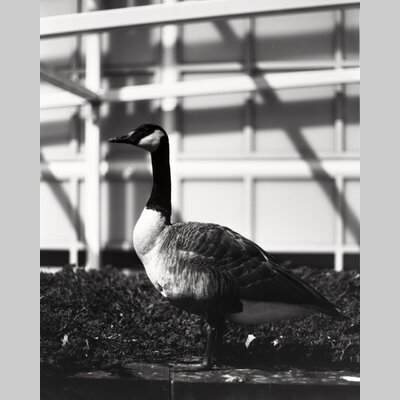pictoral 35mm microfilm
I recently got into analog photography, and one concern is the ongoing costs of film. I started bulk-loading conventional film (Ilford HP5+), but still wanted to go cheaper. The eBay film market is pretty cutthroat, so I figured I would have to go much weirder to get any sort of bargain. Finally, I noticed a lot of 35mm microfilm, intended for archival storage of documents: Kodak Imagelink HQ, a.k.a Kodak 1461. So obviously I bought 1000 feet of it (like roughly 200 normal rolls of film).
For the impatient, higher resolution scans may be found on my Flickr.
the problems
Microfilm is definitely not intended for photographic use. The main problems:
- No perforations, so 99.9% of cameras will not be able to advance it properly
- No instructions for development in common chemicals
- No instructions for exposure
- Extremely high contrast, intended for pure black/white image storage
perforations?
Almost all 35mm cameras use the film perforations for controlling film advance and to manage proper spacing. Some even use the sprocket holes to cock the shutter. There are workaround for this.
Film advance generally pulls both with the takeup spool and the sprocket. The takeup spool is usually not locked to the film advance; it has just enough friction to pull the film while advancing, but not too much to prevent rewind. On some cameras, this is enough to simply allow use of unperforated film. On most, however, the takeup spool will slip. Even on cameras with nearly enough friction, spacing will be inconsistent. One hack is to somehow increase the friction, which can be done by adding a little glue inside the takeup spool.
Alternatively, a very, very small number of 35mm cameras have some other system for film advance and spacing that doesn't rely on perforations. I'm on team Nikon, and forum rumors about the Nikon N90S lead me to buy one, but I have empirically found it can't shoot unperforated. My second choice was the most reliable lead: the Canon EOS 10S. This camera uses a roller that spins as film moves across it to control spacing. While I'm not excited about buying into a new lens mount (I think I'll stick with one 50mm prime), the EOS 10S works very nicely with this microfilm.
development/exposure?
Again, since this is not the intended usage, Kodak doesn't publish any instructions for hand-processing using normal darkroom chemicals. Delving into a maze of forum posts spanning decades gave me a few starting points. Rodinal stand development was popular at extremely low dilutions like 1:300. Also, Imagelink HQ was sometimes compared to the long-discontinued Kodak Technical Pan. I found Kodak's whitepaper #P-255 which details a variety of approaches to developing Tech Pan, including examination of time, contrast, agitation technique, ISO, and more. I started with HC-110, very infrequent agitation (once per five minutes), dilutions around 1:119, and exposing the film around ISO 100. After many iterations of experimentation with agitation, dilution, exposure, and development length, I now have a recipe I'm pretty happy with.
Kodak Imagelink HQ at ISO 12
Expose as usual at ISO 12. Note that the film is somewhat less red-sensitive.
Dilute HC-110 at 1:300 into a 600mL daylight tank (i.e. 2mL of HC-110) with a single roll.
Agitate for 30 seconds.
Stand for 60 minutes with no additional agitation at any point.
Wash and fix conventionally.
Conclusions, Limitations, and Opportunities
The film speed is... pretty low. 12 is fast enough to hand-hold during sunlight, but any increase would be appreciated. I believe faster speed with HC-110 results in a huge increase in contrast. My recipe only barely tames the contrast to the point of being scannable and not losing detail.
On the subject of detail, there's tons of it, and essentially no grain; it's comparable, if not finer than, 6x9 medium format. If you love counting bricks, this is the film for you. Deep shadow detail is not great. Highlight detail is pretty well-controlled by the stand development. Sharpness seems slightly less than perfect. I intend to experiment with Rodinal, which is known for increasing accutance, and also for well-behaved stand development.
A common thread in development suggestions for microfilm was the usage of low-contrast developers. I put several rolls in Photographers Formulary's TD-3 Techpan Developer, but had extremely unsatisfying results. Flickr user 'threepinner' reports a film speed of ISO 100 (!!!) in a derivative of HW Control. This developer is not commercially available, has a short mixed shelf-life, and uses a variety of chemicals I would prefer not to mix at home. The results, however, are clearly excellent.



